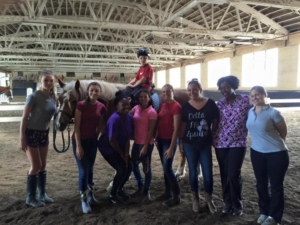Click the picture for the full May 2016 newsletter!
Hippotherapy is a treatment strategy utilized by occupational therapists for clients with sensory and motor dysfunction. As an occupational therapist, we understand the child’s emotional, physical, and sensory needs and how to optimally facilitate the treatment of these needs through hippotherapy. Because hippotherapy provides intense sensory input, it is important for the occupational therapist to have training in sensory integration theory and techniques. The horses rhythmical movement mimics the 3 dimensional movement of the human gait thus providing gentle vestibular input that facilitates organization/attention and an overall calming sense to the child. For a child with physical deficits, it provides movement through space that the rider has often never experienced. As the rider experiences spatial awareness through movement without the stress of rigid and uncooperative muscles, a foundation has been laid for visual spatial awareness and orientation in space. This provides the child with normal movement that may not otherwise be experienced.
A faster walk or trot provides both vestibular and proprioceptive input thus facilitating arousal, body awareness, spinal extension, breathe support, balance reactions, and a general increase in processing. Changing the rider’s position on the horse can also facilitate postural alignment, visual attention, normalization of tone, arousal, and greater vestibular and proprioceptive input. For example changing the position of the child’s head (laying on the back over the barrel of the horse) provides greater vestibular input. In addition, changes in movement patterns of the horse can facilitate greater balance reactions, body awareness and the like. Upper extremity range of motion, strengthening, bilateral coordination, and fine motor skills can be integrated into the session within a fun and motivating way using the horse as a therapeutic treatment tool. Facilitation of upper extremity movements also assists in trunk stability, control, and movement. Constant physical contact with the horse provides tactile and proprioceptive input. Additional grooming activities, petting, and affection with the horse provides tactile input and emotional bonding opportunities. Bonding with an animal often is the first true friendship many children experience and provides the foundation for reciprocal interactions with peers and family members. With consistent interaction with the horse, hippotherapy provides children with opportunities for increased emotional, social, and spiritual development.


